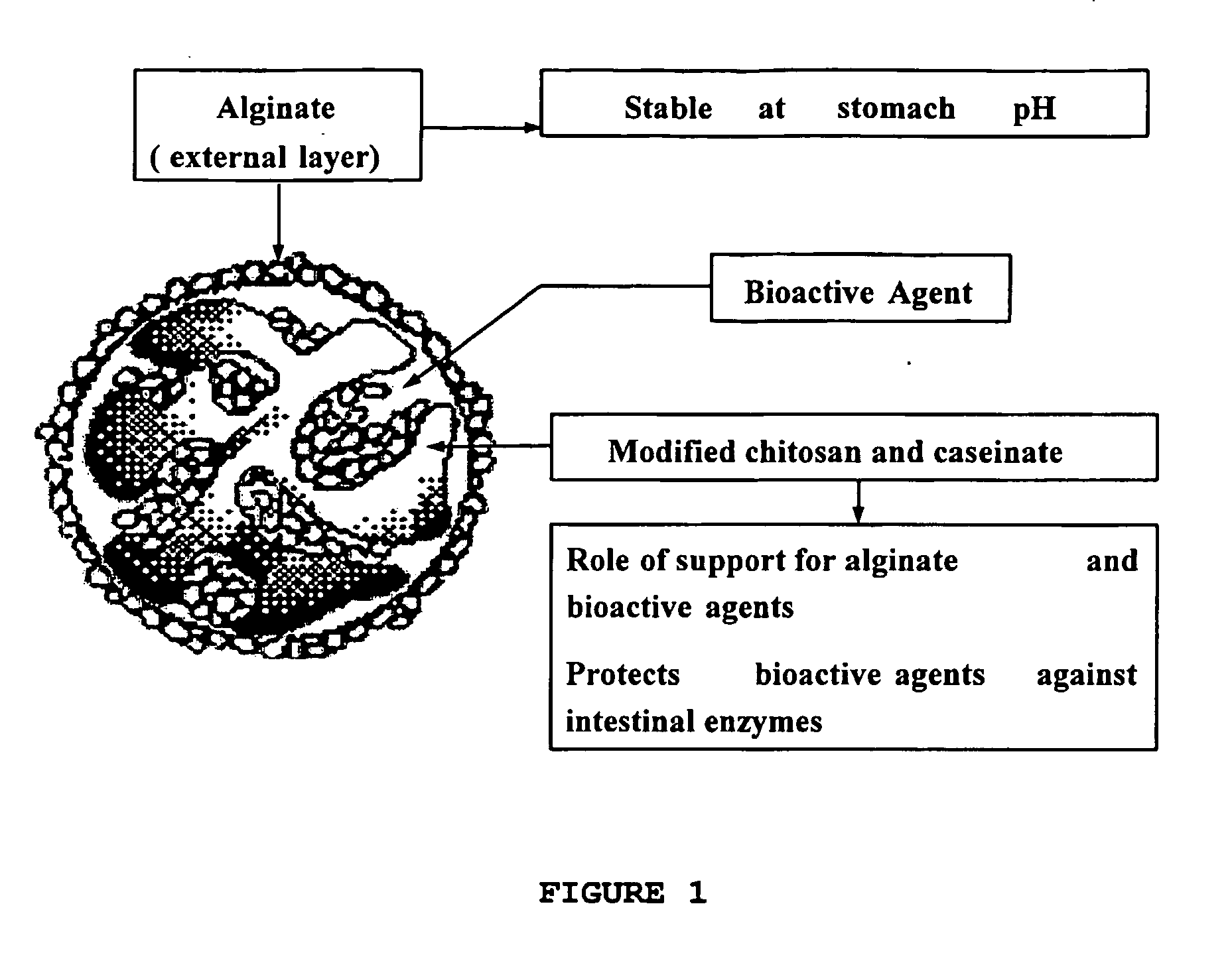Biocompatible compositions as carriers or excipients for pharmaceutical and nutraceutical formulations and for food protection
a biocompatible composition and carrier technology, applied in the direction of biocide, plant growth regulators, pharmaceutical non-active ingredients, etc., can solve the problems of inability to keep biologically active compounds, inability to manufacture microparticles containing biologically active compounds, and loss, in part, of physical-chemical characteristics of particles
- Summary
- Abstract
- Description
- Claims
- Application Information
AI Technical Summary
Benefits of technology
Problems solved by technology
Method used
Image
Examples
example 1
Derivatization of Chitosan and of Alginate by Acylation with Fatty Acids Residues and Cross-Linking with Bifunctional Agents.
[0073] Chitosan is derivatized with acid chlorides of fatty acids, giving amidic derivatives, involving part of the amino group of C2 of the aminoglucose units. Further cross-linking with dialdehydes occurs at the remaining (nonacylated) free amino groups.
[0074] IChitosan and alginate are modified with caproic acid or palmitic acid and cross-linked with glutaraldehyde. Derivitization of chitosan and alginate is done at pH 5.5-7.0 at a temperature of 60-100 degrees Celsius for 1-3 hours.
[0075] From Fourier transform infrared (FTIR) analysis (FIG. 2), it appears that acylation occurs first (coupling with fatty acids). An increase of the band in the 1700 cm−1 spectral region appears after modification for the elongation vibration of the C═O groups. The same phenomenon is observed for the band at 2980 cm−1, which might be due to the presence of C—H groups (pre...
example 2
Beads and Microparticles Based on Modified Chitosan, Alginate, and Milk Proteins, Including Pharmaceutical and Nutraceutical Agents
[0078] The presence of calcium caseinate creates a microenvironment where different degree of ionotropic gelation is observed inside the microparticles. Whey proteins can be added as a source of nutrient for probiotic bacteria.
[0079] Chitosan modified with caproic acid was dissolved (2-3%) in slightly acidic medium (pH 5.0-6.5) and mixed with lactic bacteria (or other active agent) solutions in presence of milk proteins (0.2-1% caseinate, rich in calcium). Beads are formed in solutions of tripolyphosphate, sedimented, recovered, suspended in native or modified alginate (1-3%), for various intervals and then, the medium was dripped in 5-10% CaCl2, forming alginate beads.
example 3
Formulation of Therapeutic Enzymes within Chitosan / Alginate Microparticles
[0080] Catalase (EC 1.11.1.6) is an enzyme (240 kDa) that catalyzes the decomposition of hydrogen peroxide. Therapeutic forms of catalase are of interest for treating infections via intra-peritoneal administration.
[0081] To prepare a therapeutic formulation of this enzyme, catalase is formulated into polymeric spheres and the efficiency of such a beaded matrix is evaluated by determining catalytic activity (i.e. kinetic analysis of H2O2 decomposition by spectrophotometric measurement of ΔA / min at 240 nm).
[0082] Carbohydrate (alginate, chitosan and their derivatives) activated by treatment with Na-periodate chains for 3-12 hours generate carboxylic groups that bind enzymes via the e-amino group of the lysine residues in the enzyme. First, catalase is immobilized on alginate activated by Na-periodate activation. The alginate-catalase conjugate solution is dripped into 5-10% CaCl2 solution for ionotropic gela...
PUM
| Property | Measurement | Unit |
|---|---|---|
| diameter | aaaaa | aaaaa |
| diameter | aaaaa | aaaaa |
| diameter | aaaaa | aaaaa |
Abstract
Description
Claims
Application Information
 Login to View More
Login to View More - R&D
- Intellectual Property
- Life Sciences
- Materials
- Tech Scout
- Unparalleled Data Quality
- Higher Quality Content
- 60% Fewer Hallucinations
Browse by: Latest US Patents, China's latest patents, Technical Efficacy Thesaurus, Application Domain, Technology Topic, Popular Technical Reports.
© 2025 PatSnap. All rights reserved.Legal|Privacy policy|Modern Slavery Act Transparency Statement|Sitemap|About US| Contact US: help@patsnap.com



